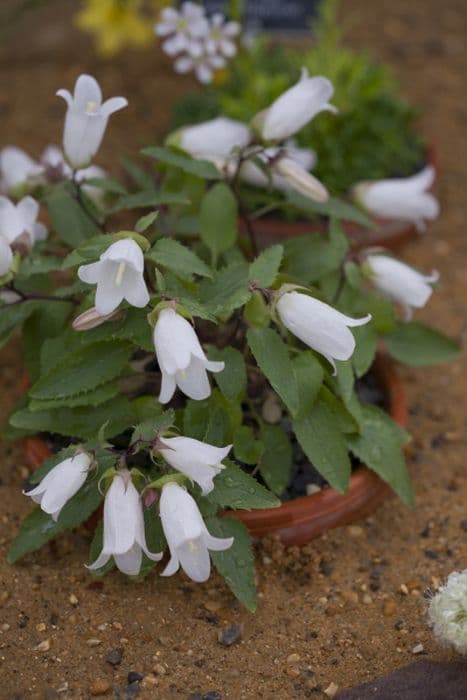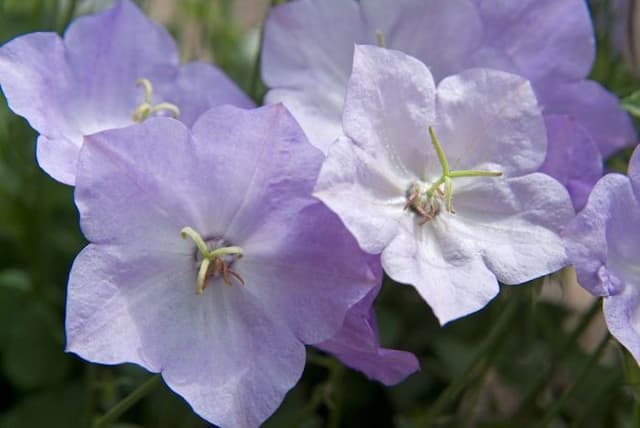Milky bellflower Campanula lactiflora

ABOUT
The Campanula lactiflora, commonly referred to as the Milky Bellflower, is a charming perennial plant that boasts a captivating display of flowers. Characterized by its upright form, this bellflower variety is adorned with clusters of bell-shaped blooms, which are typically found in shades of soft blue to violet, although some cultivars may display white or pink flowers. The blossoms are arranged in a pyramidal fashion at the top of sturdy stems, providing a visually appealing structure. The foliage of the Milky Bellflower is comprised of lush, green leaves that offer a pleasing background to its delightful flowers. The leaves can be of various shapes, including ovate to lanceolate forms, and they often have slightly serrated edges. The overall appearance of this perennial is one of grace and delicacy, with its lovely flowers attracting pollinators such as bees and butterflies to the garden. In bloom, the Milky Bellflower exudes a serene aesthetic, making it a popular choice for cottage gardens, borders, and flower beds where its alluring presence can be fully appreciated.
About this plant
 Names
NamesFamily
Campanulaceae
Synonyms
Milky Bellflower, Caucasian Bellflower, Broad-Leaved Bellflower
Common names
Campanula lactiflora, Campanula turbinata, Campanula alba, Campanula latifolia var. alba, Campanula sibirica, Campanula suaveolens.
 Toxicity
ToxicityTo humans
The Milky Bellflower, Campanula lactiflora, is not considered toxic to humans. There are no significant toxic effects reported from ingesting this plant, and it doesn't typically pose a risk if touched or consumed in small quantities. However, as with any non-food plant, individual sensitivity can vary, and it's always a good idea to discourage consumption by children and pets.
To pets
The Milky Bellflower, Campanula lactiflora, is generally not considered a toxic plant to pets. There is no well-documented toxicity in domestic animals such as dogs and cats. Therefore, ingestion of this plant is not expected to cause significant symptoms or long-term consequences. Nevertheless, pet owners should still practice caution, as individual pets can have varying sensitivities, and consuming plants that are not part of their normal diet can sometimes result in mild gastrointestinal upset.
 Characteristics
CharacteristicsLife cycle
Perennials
Foliage type
Deciduous
Color of leaves
Green
Flower color
Blue
Height
4 feet (1.2 meters)
Spread
2 feet (0.6 meters)
Plant type
Herb
Hardiness zones
4
Native area
Caucasus
Benefits
 General Benefits
General Benefits- Aesthetic Appeal: Adds a touch of beauty to gardens with its tall spires of bell-shaped flowers, which range in color from white to blue to purple.
- Attracts Pollinators: Its blooms attract bees, butterflies, and other pollinating insects, fostering biodiversity.
- Durable Perennial: It is a hardy perennial that can survive in a variety of climates and returns each year.
- Low Maintenance: Requires minimal care once established, making it a suitable plant for both novice and experienced gardeners.
- Cottage Garden Style: Ideal for achieving a traditional cottage garden look due to its structure and flowering pattern.
- Border Plants: Can be used effectively as border plants in garden beds due to their height and volume.
- Cut Flowers: Their stems and blooms work well as cut flowers, providing material for indoor flower arrangements.
- Variety of Uses: Works well in mixed borders, as part of a mass planting, or standing alone as a specimen plant.
 Medical Properties
Medical PropertiesThis plant is not used for medical purposes.
 Air-purifying Qualities
Air-purifying QualitiesThis plant is not specifically known for air purifying qualities.
 Other Uses
Other Uses- Flower Arranging: The milky bellflower's tall, elegant stems and star-shaped flowers make it a beautiful candidate for fresh bouquets and arrangements.
- Garden Borders: Due to their height and colorful blooms, milky bellflowers are often used to add vertical interest in perennial border gardens.
- Butterfly Attraction: The nectar-rich flowers of Campanula lactiflora attract pollinators such as butterflies, serving as a natural way to support local ecosystems.
- Natural Dyes: The flowers of the milky bellflower can be used to create natural dyes for fabrics, producing a range of blue hues.
- Educational Resource: These plants serve as a living example to teach botanical concepts such as plant structure, pollination, and lifecycle in schools and educational gardens.
- Photography Subject: With its striking appearance, the milky bellflower is a popular subject for garden photographers and plant enthusiasts to capture.
- Culinary Garnish: While not widely consumed, the flowers can be used as a decorative, edible garnish on salads and desserts after proper identification and confirmation of edibility.
- Frost Tolerance Indicator: Gardeners may use the hardiness of the milky bellflower as an indicator plant to help determine the onset of frost-sensitive planting periods.
- Ceremonial Plants: In some cultures, the milky bellflower may be used in ceremonies or celebrations for its symbolic associations with humility and everlasting love.
- Bee Conservation: By planting milky bellflowers, gardeners can contribute to bee conservation efforts by providing a source of nectar during blooming months.
Interesting Facts
 Feng Shui
Feng ShuiThe Milky Bellflower is not used in Feng Shui practice.
 Zodiac Sign Compitability
Zodiac Sign CompitabilityThe Milky Bellflower is not used in astrology practice.
 Plant Symbolism
Plant Symbolism- Gratitude: The Campanula lactiflora, commonly known as the Milky Bellflower, often symbolizes a feeling of gratitude or thankfulness towards someone.
- Constancy and Perseverance: Due to its hardy nature and ability to thrive in various conditions, the Milky Bellflower represents constancy and perseverance in the face of challenges.
- Enduring Love: Owing to its bell-shaped flowers that tend to stay on the stem for an extended period, the Milky Bellflower signifies enduring or everlasting love.
 Water
WaterMilky Bellflower should be watered deeply whenever the top inch of soil feels dry to the touch, which typically translates to once or twice a week, depending on climatic conditions. During periods of drought or extreme heat, watering frequency should increase to maintain consistent soil moisture. For a standard-sized plant, use approximately half a gallon of water at each watering, ensuring the water penetrates the root zone without causing waterlogging.
 Light
LightMilky Bellflower thrives best in full sun to partial shade conditions. The ideal spot would receive morning sunlight and afternoon shade, or dappled sunlight throughout the day, protecting the delicate blooms and foliage from the intense midday sun.
 Temperature
TemperatureMilky Bellflower fares well in a range of temperature conditions, with ideal growing temperatures between 60°F and 70°F. However, the plant is hardy and can tolerate minimum temperatures down to around 20°F and maximum temperatures up to about 85°F without significant stress.
 Pruning
PruningPruning Milky Bellflower encourages a bushier growth and more blooms. After the first flush of flowers has faded, cut back the flower stems by one-third to promote a second bloom. General pruning is best done in late winter or early spring before new growth begins, removing dead or damaged stems to maintain plant health and shape.
 Cleaning
CleaningAs needed
 Soil
SoilMilky Bellflower thrives in well-draining soil rich in organic matter. A mix comprised of equal parts garden soil, compost, and perlite or sand creates an ideal environment. The soil pH should be neutral to slightly alkaline, ideally within the range of 6.0 - 7.5.
 Repotting
RepottingMilky Bellflower generally does not need frequent repotting and can thrive in the same pot for several years. It should be repotted when it becomes root-bound or every 2-3 years to refresh the soil.
 Humidity & Misting
Humidity & MistingMilky Bellflower does well in average room humidity. It does not require any special humidity conditions, making it adaptable to most indoor environments without the need for additional humidity control.
 Suitable locations
Suitable locationsIndoor
Place in bright, indirect light and ensure pot has drainage.
Outdoor
Plant in sun to partial shade with some shelter from wind.
Hardiness zone
3-8 USDA
 Life cycle
Life cycleCampanula lactiflora, commonly known as the Milky Bellflower, begins its life cycle from seeds, which germinate in the spring when the soil warms up, requiring light for successful germination. After germination, the seedlings develop into rosettes of foliage and establish a strong root system during their first growing season. In their second or third year, depending on environmental conditions, the plants mature and produce tall flowering stalks, often reaching up to 1.5 meters in height, with clusters of bell-shaped, blue to violet flowers blooming in the summer. After flowering, the plant sets seed, which may drop to the ground to self-seed or can be collected for propagation. During the fall and winter, the above-ground portions of the plant die back as it enters a period of dormancy, with the root system surviving to sprout new growth when conditions improve in the spring. As a perennial, Campanula lactiflora can continue this cycle for several years, creating larger clumps and more flowering stems each year with proper care.
 Propogation
PropogationPropogation time
Spring to early summer
Campanula lactiflora, commonly known as the Milky Bellflower, is typically propagated by division, which is the most popular method for this perennial plant. The best time for dividing Milky Bellflower plants is in early spring or fall, when the plant is not in active growth. To propagate by division, carefully dig up an established clump of the plant and gently separate it into smaller sections, ensuring that each section has a piece of the root system attached. Replant these divisions at the same depth they were previously growing, spacing them about 12 to 15 inches (approximately 30 to 38 centimeters) apart to allow for adequate growth and air circulation. Water the newly planted divisions thoroughly to help establish the roots in their new location. This method is straightforward and typically results in a high success rate, making it a favored choice among gardeners.









